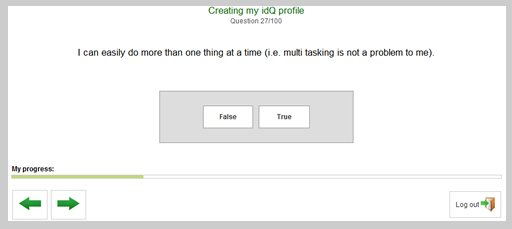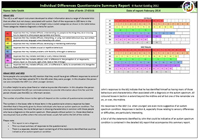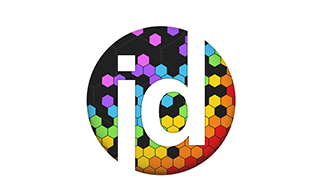WHAT IS IT?
The idQ stands for Individual Differences Questionnaire.
It was developed by Rachel Golding who is a clinical psychologist.
The profile produced on the basis of responses to the idQ is NOT A DIAGNOSIS.
A diagnostic assessment for autism would include an exploration of developmental history (i.e. what the person was like when younger) and the impact of the sort of characteristics identified by the idQ on everyday functioning. This type of assessment would need to be carried out by someone who has had specialist training in diagnosing autism.
CONTACT RACHEL GOLDING
WHAT ARE ITS AIMS?
It aims to promote a positive awareness and understanding of those differences in thinking and behaving that are often associated with autism:
- providing visual feedback on the extent to which the person’s responses may be explained by autism
- demonstrating how someone who is autistic will share certain traits identified by other autistic people but will have their own individual profile
- helping the individual to explore specific characteristics associated with autism and to understand what effect these could have on everyday life
- offering practical solutions for some of the difficulties that the individual may be experiencing as a result of their differences in processing information
WHO IS IT AIMED AT?
It is for young people and adults who:
- feel they may be autistic and wish to explore this possibility on their own and in private (and/or with the support of close friends or family)
- are already consulting a professional (e.g. psychologist, counsellor, GP, psychiatrist) because they have been experiencing some difficulties and it has been suggested by the person advising them that autism may explain some of these difficulties
- are already undergoing autism-specific diagnostic assessment work and wish to take an active part in the process
- have already received a diagnosis of autism and want to discover ways in which they are similar to, and also differ from, others with a diagnosis of autism as well as those described as neurotypical
- want to learn some of the theory behind these differences and what practical strategies can be used to minimise any distress caused by them
HOW DOES SOMEONE ACCESS THE idQ?
Individuals who wish to complete the idQ on line will need a:
- user name
- password
These will have been given to them by the professional with whom they have been consulting or directly from Rachel Golding through personal contact or recommendation. Requests for access to the questionnaire can be made by email to info@idq.me.
WHAT IS INVOLVED IN COMPLETING THE idQ?
The idQ takes approximately 20 minutes to complete. Once the person has logged in, instructions will appear before the first item is presented.
There are 100 statements written in the first person (e.g. I prefer doing things like watching a favourite DVD or doing a crossword puzzle with someone else rather than on my own) and the person completing the questionnaire has to decide whether or not the statement describes him or her. The person makes response by clicking on one of two buttons:

A response has to be made before it is possible to move on to the next item. However, the person can go back and amend responses if necessary.
WHAT HAPPENS AFTER THE idQ HAS BEEN COMPLETED?
Once the person has completed the idQ, the responses are analysed and two different styles of coloured profile can be produced.
Profile1:

This is a chart that gives a summary of the responses given. The responses are organised into coloured bands corresponding with diagnostic criteria for autism. The more coloured boxes on the chart, the more the individual has identified him or herself as having characteristics in common with people who have a diagnosis of autism. Most people who are not autistic have profiles where the coloured bands do not extend past the mid-line of the chart).
 Summary Report:
Summary Report:
The table/s produced can be inserted into a summary report that explains the results obtained from the questionnaire/s.

Profile 2:
This is a diagram that gives the information in a different visual format. Each coloured hexagon represents a response that is often, but not always, given by someone who has a diagnosis of autism. The images produced can be used to demonstrate the wide variation in presentation of people who are autistic. Please note there is no relationship between the coloured areas and specific functions of the brain.
In future this profile can also be used to explore the responses made to the idQ and what these might mean for the individual (see AidEx below)
AidEx
AidEx stands forAutism individual differences Explored and Explained. This is currently being developed. The aim is that anyone completing the idQ will be able to access their individual profile, click on each hexagon and access information and strategies relevant to that specific item on the idQ.

 Autism Spectrum Report:
Autism Spectrum Report:
The profile can be inserted into the Autism Spectrum report.
 Detailed Report:
Detailed Report:
A detailed report is also provided. This lists all the statements where the individual has made a response often associated with autism and organises them into sections that correspond with diagnostic criteria for autism. This can be useful if the individual wishes to have a report to give to someone else.
WHAT IS THE idQY?
Some people who complete the idQ mention that they would have given different responses to some of the items if they had been asked to fill in the idQ when they were younger. In this situation, the person is given the option to complete the idQY (i.e. when younger version) after completing the idQ. Comparison between the idQ and idQY gives valuable information about the way in which the person may have changed over the years and is particularly useful for both research purposes and for diagnostic assessment.
WHAT IS THE idQi?
There is another version of the idQ called the idQi (informant version). The only difference between the two is that idQi is written in the third person (e.g. He seems to prefer doing things like watching a favourite DVD or doing a crossword puzzle with someone else rather than on his own) and is completed by someone who knows the individual really well.
There are circumstances where this additional information is helpful (particularly where a formal diagnostic assessment for autism is being requested) but the idQi should never completed without the knowledge and consent of the person completing the idQ and should only be filled in by someone whose opinion is trusted and valued by that person. If this is not the case and the person completing the idQi has identified characteristics that the individual feels are negative, this could damage self-esteem and/or lead to feelings of resentment.
WHAT MAKES THE idQ DIFFERENT?
There are several other questionnaires that explore characteristics associated with autism and can be accessed on line. The most well known of these are:
- AQ (Autism Spectrum Quotient: Baron-Cohen et al, 2001) http://www.autismresearchcentre.com/arc_tests >
- RAADS-R (Ritvo Autism Asperger Diagnostic Scale-Revised: Ritvo et al 2010) http://www.aspietests.org/raads/ >
- Aspie Quiz http://rdos.net/eng/Aspie-quiz.php
These have been identified as helpful when used as a screening tool or as an aid to diagnosis. However, some people have reported (personally to the author of the idQ and also on online blogs such as www.wrongplanet.net ) that they have found many of the questions difficult to understand and/or that the process of completing the questionnaire was a confusing experience. When developing the idQ every effort was made to try and ensure that the statements were written so they:
- Were simple and clear, avoiding ambiguity or use of idioms
- Did not expect the person to compare his or her behaviour with that of other people
- Did not assume that the person completing the questionnaire would have awareness of the impact his or her behaviour might have on others
- Would not create anxiety or undermine self esteem
The other big difference with the idQ is in the way that the responses to the questionnaire are summarised and presented to the individual. Each person has an individual coloured profile that can be used as the basis for exploring individual differences in more detail. This provides an opportunity for the person to:
- feel positive about difference
- learn more about autism
- become optimistic for the future
